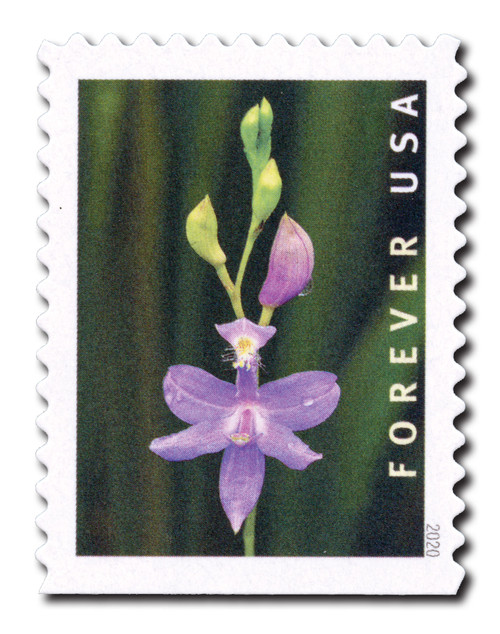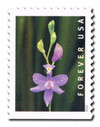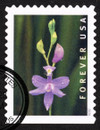
# 5454 - 2020 First-Class Forever Stamp - Wild Orchids (booklet): Calopogon tuberosus
US #5454
2020 Calopogon tuberosus – Wild Orchids (Booklet)
- Pictures the grass pink orchid
- Part of the Wild Orchids set picturing nine orchid species native to the United States (one species shown twice)
Stamp Category: Definitive
Set: Wild Orchids
Value: 55¢ First Class Mail Rate (Forever)
First Day of Issue: February 21, 2020
First Day City: Coral Gables, Florida
Quantity Issued: 500,000,000
Printed by: Banknote Corporation of America
Printing Method: Offset
Format: Double-sided Booklets of 20
Perforations: Serpentine die cut 10 ¾ x 11 on 2 or 3 sides
Tagging: Phosphor tagged paper, block
Why the stamp was issued: To showcase the beauty and diversity of different species of wild orchids.
About the stamp design: Pictures a photograph by Jim Fowler of the grass pink orchid, a species that grows wild in the United States.
First Day City: The First Day of Issue Ceremony was held in Coral Gables, Florida, home to the headquarters of the American Orchid Society.
About the Wild Orchids set: Includes 10 stamps picturing photographs by Jim Fowler of nine different orchids (one species shown twice) native to the United States. Species include: the three birds (pictured twice), California lady’s slipper, crested coralroot, showy lady’s slipper, marsh lady’s tresses, eastern prairie fringed, greater purple fringed, grass pink, and yellow cowhorn orchids. These are all beautiful wildflowers that most people don’t get the opportunity to see. They’re all hard to find today.
History the stamp represents: When it comes to wildflowers, few are as striking as orchids. Their unusual structures, vivid patterns, and bright colors bring natural beauty to any environment. While the most famous varieties are native to the tropics, there are many native to North America, too.
One of the most widely occurring orchid species in North America is Calopogon tuberosus – the “grass pink” orchid. It’s found in bogs, meadows, swamps, and other wetland habitats throughout the eastern half of the United States and Canada. The plant earned its name from its grass-like leaves and magenta or pink flowers. Grass pink orchids are up to two and a quarter feet tall with grass-like leaves up to a foot long. The flowers grow from a central stem (also known as a spike) and number from two to 15 blooms per plant.
Grass pink orchids are pollinated primarily by bumblebees and other large long-tongued bees. Other pollinators may be attracted to the flowers, but their size and shape rarely allows them to transfer pollen. While most orchid flowers have the same orientation, the grass pink orchid’s blooms appear upside down when compared. While not completely invulnerable, the grass pink orchid has remained relatively untouched by environmental threats. It’s likely they will be around for everyone to enjoy for generations to come.
US #5454
2020 Calopogon tuberosus – Wild Orchids (Booklet)
- Pictures the grass pink orchid
- Part of the Wild Orchids set picturing nine orchid species native to the United States (one species shown twice)
Stamp Category: Definitive
Set: Wild Orchids
Value: 55¢ First Class Mail Rate (Forever)
First Day of Issue: February 21, 2020
First Day City: Coral Gables, Florida
Quantity Issued: 500,000,000
Printed by: Banknote Corporation of America
Printing Method: Offset
Format: Double-sided Booklets of 20
Perforations: Serpentine die cut 10 ¾ x 11 on 2 or 3 sides
Tagging: Phosphor tagged paper, block
Why the stamp was issued: To showcase the beauty and diversity of different species of wild orchids.
About the stamp design: Pictures a photograph by Jim Fowler of the grass pink orchid, a species that grows wild in the United States.
First Day City: The First Day of Issue Ceremony was held in Coral Gables, Florida, home to the headquarters of the American Orchid Society.
About the Wild Orchids set: Includes 10 stamps picturing photographs by Jim Fowler of nine different orchids (one species shown twice) native to the United States. Species include: the three birds (pictured twice), California lady’s slipper, crested coralroot, showy lady’s slipper, marsh lady’s tresses, eastern prairie fringed, greater purple fringed, grass pink, and yellow cowhorn orchids. These are all beautiful wildflowers that most people don’t get the opportunity to see. They’re all hard to find today.
History the stamp represents: When it comes to wildflowers, few are as striking as orchids. Their unusual structures, vivid patterns, and bright colors bring natural beauty to any environment. While the most famous varieties are native to the tropics, there are many native to North America, too.
One of the most widely occurring orchid species in North America is Calopogon tuberosus – the “grass pink” orchid. It’s found in bogs, meadows, swamps, and other wetland habitats throughout the eastern half of the United States and Canada. The plant earned its name from its grass-like leaves and magenta or pink flowers. Grass pink orchids are up to two and a quarter feet tall with grass-like leaves up to a foot long. The flowers grow from a central stem (also known as a spike) and number from two to 15 blooms per plant.
Grass pink orchids are pollinated primarily by bumblebees and other large long-tongued bees. Other pollinators may be attracted to the flowers, but their size and shape rarely allows them to transfer pollen. While most orchid flowers have the same orientation, the grass pink orchid’s blooms appear upside down when compared. While not completely invulnerable, the grass pink orchid has remained relatively untouched by environmental threats. It’s likely they will be around for everyone to enjoy for generations to come.














